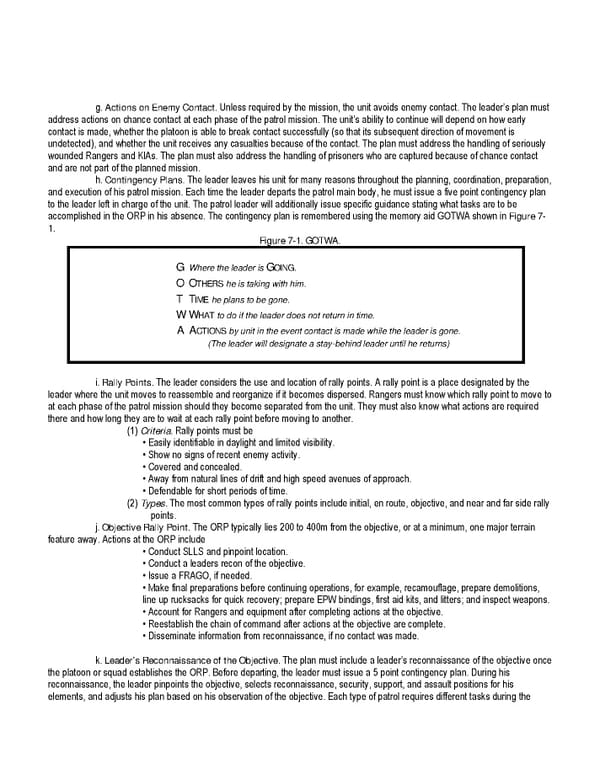g. Actions on Enemy Contact. Unless required by the mission, the unit avoids enemy contact. The leader’s plan must address actions on chance contact at each phase of the patrol mission. The unit’s ability to continue will depend on how early contact is made, whether the platoon is able to break contact successfully (so that its subsequent direction of movement is undetected), and whether the unit receives any casualties because of the contact. The plan must address the handling of seriously wounded Rangers and KIAs. The plan must also address the handling of prisoners who are captured because of chance contact and are not part of the planned mission. h. Contingency Plans. The leader leaves his unit for many reasons throughout the planning, coordination, preparation, and execution of his patrol mission. Each time the leader departs the patrol main body, he must issue a five point contingency plan to the leader left in charge of the unit. The patrol leader will additionally issue specific guidance stating what tasks are to be accomplished in the ORP in his absence. The contingency plan is remembered using the memory aid GOTWA shown in Figure 7- 1. Figure 7-1. GOTWA. G Where the leader is GOING. O OTHERS he is taking with him. T TIME he plans to be gone. W WHAT to do if the leader does not return in time. A ACTIONS by unit in the event contact is made while the leader is gone. (The leader will designate a stay-behind leader until he returns) i. Rally Points. The leader considers the use and location of rally points. A rally point is a place designated by the leader where the unit moves to reassemble and reorganize if it becomes dispersed. Rangers must know which rally point to move to at each phase of the patrol mission should they become separated from the unit. They must also know what actions are required there and how long they are to wait at each rally point before moving to another. (1) Criteria. Rally points must be • Easily identifiable in daylight and limited visibility. • Show no signs of recent enemy activity. • Covered and concealed. • Away from natural lines of drift and high speed avenues of approach. • Defendable for short periods of time. (2) Types. The most common types of rally points include initial, en route, objective, and near and far side rally points. j. Objective Rally Point. The ORP typically lies 200 to 400m from the objective, or at a minimum, one major terrain feature away. Actions at the ORP include • Conduct SLLS and pinpoint location. • Conduct a leaders recon of the objective. • Issue a FRAGO, if needed. • Make final preparations before continuing operations, for example, recamouflage, prepare demolitions, line up rucksacks for quick recovery; prepare EPW bindings, first aid kits, and litters; and inspect weapons. • Account for Rangers and equipment after completing actions at the objective. • Reestablish the chain of command after actions at the objective are complete. • Disseminate information from reconnaissance, if no contact was made. k. Leader’s Reconnaissance of the Objective. The plan must include a leader’s reconnaissance of the objective once the platoon or squad establishes the ORP. Before departing, the leader must issue a 5 point contingency plan. During his reconnaissance, the leader pinpoints the objective, selects reconnaissance, security, support, and assault positions for his elements, and adjusts his plan based on his observation of the objective. Each type of patrol requires different tasks during the
 Ranger Handbook Page 115 Page 117
Ranger Handbook Page 115 Page 117